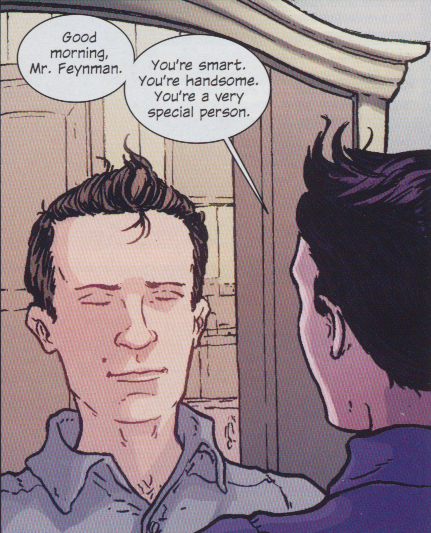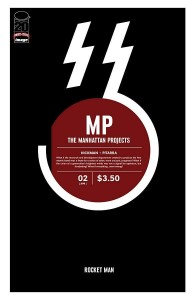
Eric’s Book
Eric: Thanks to Dan, I’ve become a huge Jonathan Hickman fan. It started with you, Dan, lending me the Fantastic Four trades that lead into FF. This made me appreciate the current Fantastic Four/Future Foudnation storylines in a way that I wouldn’t have otherwise. In fact, I might even had dropped FF without that context. Then you selected SHIELD Vol 2 #4 for the Week 7 POW and I got a sense of Hickman’s main themes. Other than father figures, he has a huge interest in timelines, alternate dimensions, and other hard science fiction . While F4 has always been Marvel’s sci-fi book, Hickman has really made the focus sci-fi instead of the usual comic book fare.
I was already primed to check out more Hickman work and I am also a fan of historical fiction and that’s why I chose to pick up The Manhattan Projects #1. It turned out to be an alternate history rather than historical fiction, but it was intriguing enough that I picked up the second issue.
Dan: Good to know that you took such a strong liking to an author I introduced you to. I think that between Hickman and Brian K. Vaughan you may start to actually listen to me when I say someone’s good.
Eric: Yeah, definitely some good recommendations. While the pencils/inks take some getting used to, Rachelle Rosenburg’s colors really have a big effect on the feel of the book. In flashbacks there’s the duality of blues and reds. In the current time there’s a certain warmth to the colors that seems to reinforce the feeling of “past” to my mind. It just feels like the 1940s. I’m not sure why it has that effect on me, but it works well.
Dan: I wasn’t as big a fan of Pitarra’s pencils in The Red Wing, but for some reason I’m a lot more into them in this book. I think it might be the fact that he’s drawing caricatures of a sort. Where Red Wing tried to be realistic and futuristic, everything about the Manhattan Project scientists looks exaggerated.
Eric: Caricatures! Yes, that’s the word that wouldn’t come to me when we discussed it this past weekend. It looks very different from the stylized look of most comics – like it’s trying and failing to look realistic – it’s the caricatures.
Dan: Since most likeness comics have an eerie, uncanny valley quality to them, I’m glad they went with this style for folks like Einstein, whose image is absolutely in the public consciousness, or Von Braun who everyone knows actually had a cybernetic arm.
Eric: Yeah, that uncanny valley in comics is what bothered me the most about Buffy Season 8. They were trying to look like the actors a little too hard. Anyway, good segue – the book opens up with a scene that is pointless other than to set up the tone of the book. It is Hitler speaking to Von Braun as he gets his cybernetic arm installed.
Dan: It is a vital and telling scene to explain Von Braun’s motivations. One of those fun scenes where the speakers think they’re talking about the same thing, but they’re not. The ideology that Von Braun follows is not what Hitler thinks it is
Eric: Once again you illustrate why I love going over these issues with you. I completely missed out on that. But it certainly explains what happens later in the issue. Next we go to our introduction to Richard Feynman in this universe in what is the first bit of humor in the issue.
Dan: And yet another scene where people think they’re talking about the same thing. While Von Braun worships the “greater good” of science in a way, Feynman worships himself.
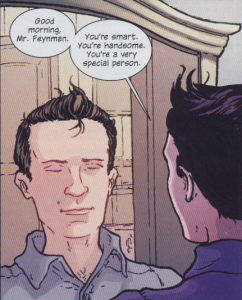
Eric: Indeed. I just love how it plays with your conceptions of why people do daily affirmations. After that Feynman is summoned to go get Einstein and report to the General. The funny thing is that Albert Einstein’s portrayal in this book is the biggest reason why I decided to check out issue #2. In the first issue Japanese Kamikaze robots come through a teleportation device and kill a large number of staffers at Los Alamos, worry is expressed that they might have hurt Einstein. Yet we see him in the same position as before – in a chair, facing a monolith with busted robots all around him. Also, while it was slightly ambiguous in the first issue, it was implied that Einstein was actually there against his will. This is confirmed in issue #2.
Dan: It’s arguable that Einstein is the character that Hickman most has to get right if he plans on this series succeeding because everyone knows him best. I’m sure we’ll get an issue detailing his backstory in due time, but making him a badass was the right choice and an absolute audience pleaser.
Eric: Yeah, we find out that the Americans have co-opted the teleportation technology as Feynman and Einstein go through it to get to the big meeting. This gives us the second great bit of humor in this issue. Apparently the teleportation technology is powered by Death Buddhists and something about the process is life-sapping. So we get the great line “the Death Buddhists keep dying,” as well as demonstration that Einstein is kind of a jerk.
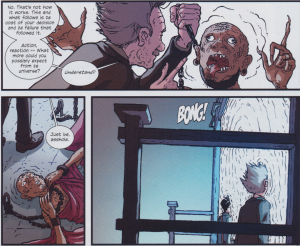
Dan: Perhaps a backhanded insult since Einstien too is there against his will, but he has not cracked.
Eric: Feynman, while getting ready to go through, has the stereotypical conversation with a non-scientist in which the non-scientist doesn’t care or understand what the scientist is saying. He mentions losing matter when going through. Given that Hickman is our writer, I don’t know if it’s an example of Feynman’s thought process or if it’ll end up being an important plot point. What’s your opinion?
Dan: Hickman rarely wastes space. That’s all I feel comfortable speculating on.
Eric: Safe bet! Hehe! We get introduced to the other minds on The Manhattan Projects as they decide whether or not to extricate Von Braun from Germany. We get the history buff fan service of Dr. Daghlian, who died in real life from a radiation accident at Los Alamos, alive in a special sci-fi containment suit. And Feynman loses the not-it game and has to go get Von Braun.
Dan: Von Braun makes an interesting play in Germany by getting all of his colleagues to commit suicide, enhancing his own value. It jives with the ruthlessness he expressed earlier and also with the fact that he shares nothing with Nazi or Allied ideology. There is only, what, “the cause”? I can’t remember
Eric: Yeah, I think it’s something like that. You and I debated this weekend whether or not he actually drank poison and was immune to it, but the all that really matters is the end result – he was alive and all the other rocket scientists were dead. So the US had to accede to his demands. At first when it looked as though he drank, I thought the one scientist they couldn’t find was going to assume Von Braun’s identity, but apparently Hickman has other plans for him.
Dan: Maybe Von Braun is like Wesley and he’s got an immunity. In any case, it’s irrelevant. I think that about sums up the book, yes?
Eric: Pretty much – the last page jumped to the narrator’s present and we learn that rocket technology continued to advance in the alternate timeline of The Manhattan Projects and Von Braun is on a rocket ship outside our solar system. That just served to annoy me that we aren’t there in real life.
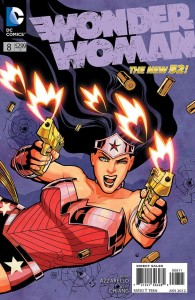
Dan’s Book
Eric: So, from alternate historical science fiction to Greek Mythology, a topic you and I both love, but which you seem to really be into.
Dan: There’s something common to the human experience inherent in mythology that really speaks to me. Not to mention that the Greek pantheon consists of some of the most dysfunctional assholes out there, which makes for some interesting stories…
Eric: So, fill us in on who Wonder Woman’s out to rescue and how she ended up in Hades.
Dan: I think we’ve dealt with parts of this arc before, but Zeus has impregnated a woman named Zola who Hera is trying to kill. Diana saves her with this big gamble involving Poseidon and Hades by promising them Hera in Zeus’ absence, but when she reneges Hades takes Zola with him into…Hades. Looking to save her unborn half-sister, Diana goes to chat with Hephaestus to Get Equipped! and that’s where this issue comes in.
Eric: So Diana really did lie? Pretty bold for a character that’s not an anti-hero
Dan: She lied to Poseidon and Hades. Does it count if you lie to psychopathic deities with little to no respect for human life? Anyway, she learned the hard way what everyone already knows: you don’t make deals with gods, especially if you plan to break them.
Eric: Even if it’s a tad cliche, I do like the scene with Hephaestus being an arms dealer. He no longer just makes swords.
Dan: Quite true. I was amused by all the automatic rifles on the walls instead of swords and other miscellaneous blade weapons. I’m also a fan of the new armor design for Diana.
Eric: So she goes with Hermes to Hades. I’m sad there’s no Ferryman on the River Styx, but I’m pleased that Hermes has bird-feet.
Dan: You neglected the important detail that Diana borrows Eros’ slightly more modern bow: a pair of golden pistols.
Eric: Yeah, that’s true. At first I didn’t make the Eros/Cupid connection because they were guns. But it came back to me at the key point in the comic. This is one super creative conception of Hades although I guess I’m also sad there’s no Cerberus.
Dan: No, but there is another kind of protector for Hades. The imprisoned souls take on all kinds of weird forms just to have a respite from their eternal nothingness.
Eric: Yeah – they’re the floor, the buildings, the statues, etc. Which allows them to be used in the same way (or a very similar way) to how the Agents in The Matrix use humans. All of a sudden a statue will come to life and attack Diana, for example.
Dan: So fight, fight fight, and they come to Zola’s house and there’s a neat little writing trick where time passes differently in Hades. You can bet that Zola’s pregnancy is now dramatically primed to go off, so to speak, at the most plot convenient moment.
Eric: Yeah, I thought it was interesting that Hermes kept Diana from revealing that to Zola. I wasn’t sure if it was just so that it can be used for the plot later or would shatter poor Zola’s mind to know so much time had passed.
Dan: There’s no getting away from Hades, though. He shows up to ruin the party and we start mixing up literary references as he offers up a Faustian bargain.
Eric: Strangely he looks like a birthday cake come to life.
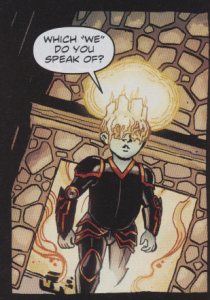
Dan: Another artist was responsible for the first drawing of Hades in this book. I wonder if Cliff Chiang had a guiding hand in that design or if he’s now saddled with it. Either way, I don’t like it. Especially since this idea that Hades and fire are intertwined comes from the Judeo-Christian notions of Satan and hell and have almost nothing to do with Greek portrayals, unless I’m way off the money. The only design element that jives with death is candles, you know, because of their impermanence.
Eric: Yeah – I was wondering what was going on with that because Disney did the same thing with their Hades. I figured it was a hell allusion, but then this happens Wonder Woman so I wasn’t sure if there was something we were missing. Because, really – there’s no fire in original Christianity. It was sulfur pits with weeping and gnashing of teeth, if I remember correctly. Anyway…..considering that Hades is almost always portrayed as a bad guy in modern, Western media (again conflating with devil? because all the gods were jerks in Greek mythology) it’s probably a bad idea to make a deal and trust him. A worse idea than when heroes do it with run-of-the-mill enemies.
Dan: Plus it’s kind of a dick move to give Hades the guns that Eros lent you. Who taught you manners, Diana?
Eric: Well, it really goes together with the theme I learned from you about the previous issues. Diana is willing to screw anyone over to save Zola. She promised Hera to Hades. After promising to bring the guns back to Eros she gives them to Hades.
Dan: Predictably, Hades utilizes said guns with heart-shaped fire discharging from the ends and Diana is…SHOT THROUGH THE HEART!
Eric: And who’s to blame? Hades gave love a bad name! I totally love how Diana is arrogant enough to think that her bracelets would block Eros’ bullets. But she’s caught in Cupid’s Chokehold! Or is she? It is certainly implied to be so.
Dan: Her mother did sleep with Zeus and lie about it, but perhaps getting back at her by sleeping with his brother is not the right move…
Battle!
Eric: Two great issues this week – I love when that happens!
Dan: I definitely love a close bout, but do we really have one?
Eric: Well, in my opinion they both have stellar art. Very different art, but great art for the stories they are trying to tell. Wonder Woman’s art is vibrant and full of fun details like Hermes’ talons. The Manhattan Projects is using color boldly in the flashbacks as well as warm tones that are evocative of the 40s. The caricatures work very well, especially on the facial closeups. So while’re they’re different, I would put them in the same boat.
Dan: I think Chiang’s art takes the edge, but mostly because I find his pantheon to be creative and interesting (minus Hades. He’s the worst design). Still, I see what you mean about The Manhattan Project and I’m a fan.
Eric: Yeah, Chiang has definitely stepped away from the look in Disney’s Hercules which seems to be the typical way – a bunch of Living Greek Statues. Everyone seems to love each new issue to see how he will depict each god. Still, I don’t think I’d let either win on art since they’re so close for me.
So, story…… On the one hand, Wonder Woman is eight issues in vs The Manhattan Projects’ two issues. That makes it hard to compare.
Dan: Oh, you know what’s a detail we forgot in the WW section? Hades forcing women to dig him is actually pretty common. Persephone, for example.
Eric: Yeah, I thought about mentioning that, but since there wasn’t a seasons thing going on like in the Persephone story, it slipped my mind by the time we got to the POW!.
I do have to say that I’m loving the characterizations in TMP. As we discussed – it’s pretty awesome to see how he’s making Einstein and others act. However, that is partly a function of how early it is in the story while we already got to meet most of the principles in Wonder Woman, so I don’t know if it’s fair to hold that against the issue.
Dan: I don’t hold it against the issue at all. What Hickman is doing in TMP is more interesting to me than WW. The story is just a touch deeper and has hints of something greater. I think it’s the better book, even if only by a slim margin
Eric: I think I agree. They’re both great issues – no regrets about the time I spent on them (more than I can say for some of the books I read this week), but I think The Manhattan Projects ekes into the victory spot.
Dan: That’s a wrap, folks. Keep on giving love a bad name out there!
